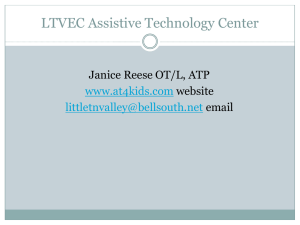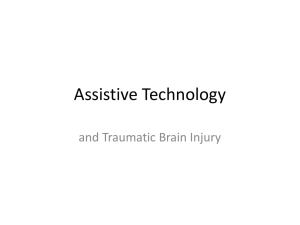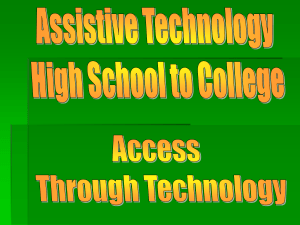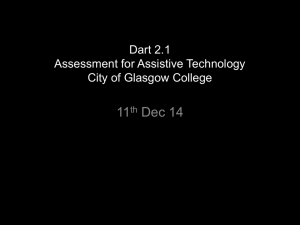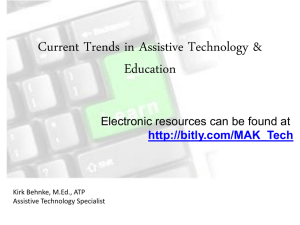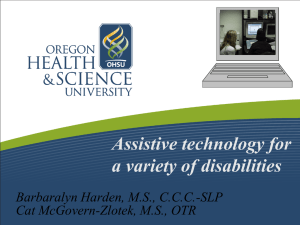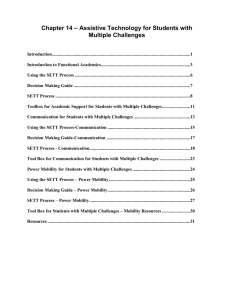PPTX - Mit
advertisement
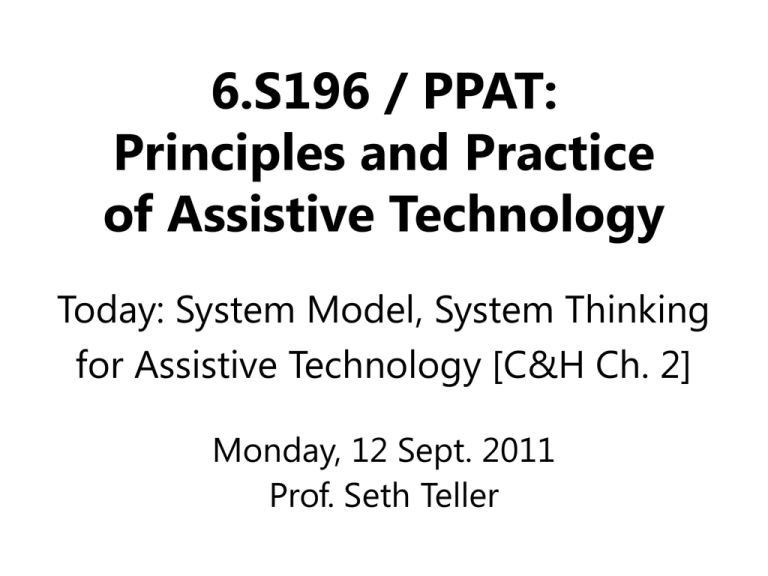
6.S196 / PPAT: Principles and Practice of Assistive Technology Today: System Model, System Thinking for Assistive Technology [C&H Ch. 2] Monday, 12 Sept. 2011 Prof. Seth Teller Administrative Issue: Lab Schedule • Please fill out circulating schedule chart with your name and availability for lab • We may adjust lab times, if this will enable participation or team formation for some – without breaking anyone else’s schedule! Today • System models – Material drawn from C&H Ch. 2 and citations • System thinking – Abstraction, specification, interfaces • Lab (today from 3-5pm in 32-044) – Wheeled mobility exercise Assistive Technology System • Assistive technology: – A device facilitating performance of some task or activity in some context • Assistive technology system view: – Assistive technology device – Human operator – Functional activity – All of which occur in some context – … with human performance our key focus! Case study: Marion • • • • • Device? Operator? Activity? Context? Performance? – Qualitative? – Quantitative? Government of Queensland HAAT Model • Someone doing something, somewhere, involving the use of an assistive technology Assistive Technology Activity Human Context Abstraction • Representation of some functional element in terms of its semantics or behavior, but without regard to its implementation • Abstraction frames some set of details that are relevant from a specific perspective • Key concepts: interfaces, combination, multiple levels of abstraction, hierarchy • For more, see 6.01, 6.02, 6.004, 6.033, … The Activity • Daily living – Self-care, mobility, communication … • Work/productivity Activity – Home, work, education … • Play/leisure – Self-expression, enjoyment … • Categories may overlap (as usual) Human Assistive Technology Context Tasks: Elements of Activities • Activities can be broken down into tasks • Individuals use their skills and abilities to complete tasks for functional outcomes • Skills may require physical, cognitive or emotional abilities for completion • Task selection or sequencing (i.e., means of combination) may also be necessary • When an individual cannot complete a task, manner of completing task must change Human Abilities • Physical – Strength, dexterity, range of motion, balance Human • Cognitive – Attention, judgment, problem solving, concentration, alertness – C&H view sensing as a subset of cognition • Affective – Emotional elements (motivation, confidence…) Assistive Technology Activity Context • ATP must understand, then match, the human’s abilities to the technology, to prevent… what? Output-centric Perspective • Goals accomplished through motor outputs – Communication, mobility, manipulation – Each requires motor skills, sensory function, and information processing • AT can replace or augment each of these: – Motor skills (examples?) – Sensory function (examples?) – Information processing (examples?) • Psychological affect influences performance – Motivation, self-efficacy, perceived activity value Other Concepts (C&H Ch. 2) • Abilities and skills – Skill development over time, transfer across tasks • Performance and learning – Routinization of frequent motor sequences – Change in character of AT usage over time • Strategies to enhance AT functionality – Highly dependent on context (how?) The Context • Difficulties arise as much from the environment as from the impairment! • Barriers – Physical – Social/attitudinal Human Assistive Technology Activity • ICF participation – Problem w/the environment Context • HAAT model captures these factors as context Multiple Contexts • Physical – Natural and built surroundings; affordances • Social – Stigmatization; expectations; assistance sources • Cultural – Learned group patterns of behavior, interaction • Institutional – Laws, policies, processes, procedures, religion • Contextual supports/barriers key to AT dev’t Marion’s Communication • Give relevant aspects for each type of context; are they supports or barriers? – Physical – Social – Cultural – Institutional Government of Queensland Assistive Technology Elements Assistive • Activity output Technology • Human interface • Environmental Activity interface Human • Functional mechanism (C&H’s Context “processor”) • AT sometimes called extrinsic enablers: – “Basis by which human performance is improved in the presence of disability” Activity Output • Communication – Transmission of information, mental states • Mobility – Moving one’s body from place to place • Manipulation – Special purpose vs. general purpose • Cognitive activities – Memory aids, information access • Higher-level activities – Abstraction! Example? Human-Technology Interface • Transmission of forces and information from human to device, and device to human • Key design idea: the use of assistive technology “adapt[s] the skills required for the task to those of the human” • Control interfaces (head/mouth/tongue/eyelid/ eyebrow/hand/finger motion, sip&puff, neural) • Display (visual, auditory, tactile, electrical) Environmental Interface • Link between device and external world • Visual – Cameras • Auditory – Microphones • Sensation of pressures and forces – Transducers • Transmission of forces or torques – Rigid or articulated mechanical linkages Functional Mechanism • C&H calls this AT element the “processor” • Component that processes data and exerts control over device’s degrees of freedom • Often a microcontroller with ability to control supplied voltages and/or currents – E.g. an audio chip driving a speaker or earbud, or a motor control board with attached servos • But: could be a simple mechanical linkage – E.g. a reacher with handle, extension, gripper Utility of HAAT Model • For existing technology: – Selection – Configuration • For development of new technology: – Research – Design – Implementation • For either new or existing technology – Evaluation Applying the HAAT Model • • • • • Activity analysis and definition User perspective Environment characteristics Technology selection Function allocation Activity Analysis and Definition • What does activity mean to the individual? – Predictor of acceptance of alternate means • What adaptations to activity are acceptable? – How it is completed – Who does it – When and how frequently it is undertaken – Stopping the activity – Substitution of one activity for another • Key inquiry: identification of task demands – Physical, cognitive or affective skills or behaviors required for successful performance of activity User Perspective • User’s attributes, perceptions, preferences • Individual choice – Which activities are important? – Perform alone, with AT, or with help from others? – How to adapt an activity? – Which assistive technology to use? – Connection to self-efficacy • Constraints imposed by operational context – Connection to caregiver availability and skills Environment Characteristics • Single vs. multi-environment use? – May require portability, flexibility, configuration – Range of temperature, light/sound levels etc. – Differences in performance across settings? – Institutional policies? Access to technology? • Setup and configuration – Complexity can conflict with portability • Funding – Some schemes dictate setting (home, work) Technology Selection • Device abandonment phenomenon: – Simple AT less likely to be abandoned by user – But: simplicity can force complexity elsewhere • General premise – Develop/select AT that is as simple as possible while still meeting the client’s needs – But: may conflict with efficient development Function Allocation • Comparison/leftover task allocation: – Assign to human/device/aide based on skills • Economic allocation – Compare aide training and payment to AT cost – Outcome depends on expected duration of use • Flexible allocation – Client varies participation based on task, skills – As skills grow, AT role grows, aide role changes Coming Up • This afternoon’s lab: wheeled mobility exercise – Meet in 32-044 at 3pm; groups depart at 315pm • Wednesday lecture – MIT Assistive Technology Information Center (ATIC) • Wednesday lab: – Reflection on mobility exercise (~1 hour) – Team formation and client matching (~1 hour) • Friday lecture: – Prof. Miller on user analysis and contextual inquiry • Reading for next week – C&H Ch. 2

